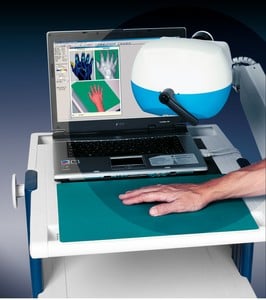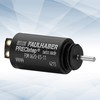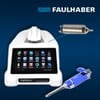STEPPER MOTOR IN BLOOD CIRCULATION SCANNER
Featured Product from FAULHABER MICROMO

STEPPER MOTOR CONTROLS LASER IN BLOOD CIRCULATION SCANNER
An adequate blood supply is essential to living tissue, providing oxygen and nutrients. Poor circulation is thus always a sign of problems somewhere in the body. Often, a simple examination of the skin or tissue is enough to allow such a diagnosis. This is where a newly developed blood circulation measuring device can really show what it's made of: a laser beam scans the patient's circulation through the tissue. A stepper motor works to mechanically position the laser beam. In this way, the sensor system is able to provide reproducible results on a miniature scale. For applications in this field, exact step sizes, appropriate low backlash reduction gears, efficient control, durability and, above all, slimline design are essential prerequisites for success.
Today, miniature drive systems play a pivotal role in a wide range of applications, and nowhere more so than in compact devices. Electronic components and optoelectronic parts seem to be shrinking by the minute. For many applications, however, miniature mechanical components are needed too - and they're available. A vast array of miniand micromotors are now on offer, with something suitable to meet all requirements.
Blood circulation scanner
Two things are often true of modern medical devices: they're large and they're expensive. A newly developed blood circulation scanner, however, shows that things can be different - it's a small and practical unit combining modern electronics, laser technology and micromechanics with a PC for evaluation. As blood circulation is essential for all bodily functions, this device allows rapid confirmation of diagnoses as well as an assessment of the progression of specific illnesses. Diabetes, occluded arteries, dermatological problems or wound healing, burns and transplants are just some examples of potential areas of use. The principle behind this mechanism is ingeniously simple: a diode laser penetrates the upper layers of tissue (approximately 0.5 to 1 mm deep, dependent on tissue type) and is partially reflected by the red blood cells. This allows both the speed and the quantity of red blood cells to be determined. A number of factors play an important role in determining the measurements. An adequately large area must be scanned in as short a time as possible, in order to create an accurate snapshot as possible. At the same time, however, this area must include as many measurement points as possible. If, however, the length of an individual step is smaller than the diameter of the laser beam, the measurements will overlap - which wastes time, without any appreciable gain in terms of quality of data. A laser beam diameter of around 1 mm is all it takes to deliver data that is of use to medical professionals. The largest area able to be scanned is around 50 x 50 cm2, with up to 255 x 255 measuring points, allowing even limbs positioned at an angle to be measured. The adjustable resolution allows, at a distance of 25 cm from the tissue, steps of approx. 3 mm, 2 mm or 1 mm, offering low, medium or high resolution. The highest resolution mode uses steps of just 0.5 mm, with overlapping measuring points. The reflected light is picked up by a CCD camera and analysed by specially developed software.
Compact mechanics
The mechanical elements of the scanner must meet a number of requirements. Firstly, it must be possible to transport the mobile device without any risk of breakage. Reliability and EMC compatibility are also important, especially for use within a medical environment. As the scanner can be operated in a number of different modes, it is important that the optical step size can be easily adjusted and yet remains reproducible to a very exactdegree. In order to save both time andmoney, an essential prerequisite is that the controls for the device can be integrated into the existing electronics. A stepper motor is the best way of meeting these various demands. Stepper motors can be used to achieve defined step sizes, without the need for any further sensors - each control pulse causes the motor to turn by a defined step angle. Thanks to the large number of steps involved, the resolution that can be achieved is excellent - and it can be further improved by use of downstream gear reduction. This is where the scanner motor really comes into is own: low-backlash gearing provides the basis for high resolution and precision. The gear system has been extensively tested and certified for this application. The life expectancy, resolution and accuracy of reproduction are all well in excess of the minimum requirements. This is one of the key advantages offered by Arsape motor-gear combination. A further benefit is the fact that stepper motors can maintain their position when no power is being supplied, or when power is supplied and they are subject to comparatively high torque. The current generation of stepper motors, with diameters of up to 15 mm, allow up to 24 steps per rotation, and can achieve speeds of up to 15,000 rotations per minute. Analysis of output is simple - an electrical impulse corresponds to a set angle of rotation, allowing the total angle or the distance travelled can be calculated from the number of impulses. In the case of the blood circulation scanner, working at low resolution and with a scanned area of 2.7 x 2.9 mm2, with 10 x 10 point resolution, the actual scanning process takes just 4 seconds. At the other extreme, with an area of 26 x 29 cm2 and 85 x 85 point resolution, six minutes are required. To achieve this, two stepper motors move a deflecting mirror along an x-y axis. The solid mechanical properties, in combination with the high precision step distances, allow precise and reproducible measurements to be achieved.









